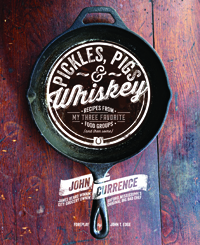With Paula Deen laying low, Southern cooking has room for a new star. Welcome John Currence, a jovial, down-home chef whose beautifully illustrated Pickles, Pigs & Whiskey: Recipes from My Three Favorite Food Groups and Then Some weds Deep South comfort with Continental technique. Currence, a New Orleanian who’s trained with the likes of Bill Neal and Larkin Selman, first made a splash with City Grocery in his newfound home of Oxford, Mississippi. Along with its sister establishments––Snackbar, Lamar Lounge, Big Bad Breakfast and Bouré ––Currence’s City Grocery Group now has a virtual lock on Oxford’s emerging restaurant scene.
 Though Pickles, Pigs & Whiskey’s self-conscious “Southern-ness” might put off purist foodies at first, a glance at such marquee Currence dishes as Tea-Smoked Duck Stir-Fry or Shrimp And Lobster Corn Dogs should put to rest any true food lover’s fears. Add to that the book’s aesthetic appeal––it even comes with its own Spotify playlist––and Pickles, Pigs & Whiskey makes a fine addition to both the kitchen counter and the coffee table. In advance of his book signings in Knoxville on May 28, 2014, Currence answered questions from Chapter 16 via email:
Though Pickles, Pigs & Whiskey’s self-conscious “Southern-ness” might put off purist foodies at first, a glance at such marquee Currence dishes as Tea-Smoked Duck Stir-Fry or Shrimp And Lobster Corn Dogs should put to rest any true food lover’s fears. Add to that the book’s aesthetic appeal––it even comes with its own Spotify playlist––and Pickles, Pigs & Whiskey makes a fine addition to both the kitchen counter and the coffee table. In advance of his book signings in Knoxville on May 28, 2014, Currence answered questions from Chapter 16 via email:
Chapter 16: One of your techniques is to deconstruct a dish, say, Natchitoches meat pies, and then update it with your personal––and sometimes heretical––story. The result in this case is Spicy Hill Country Meat Pies With Sriracha Mayonaise, a nod to central Louisiana, the Indian Samosa, and Mississippi. Do you always have a tale in mind when you design a dish?
Currence: Food is a story, or at least it is when you get confident enough to realize it is. As a young cook, I cooked for myself, trying desperately to construct things profound, complicated, and overthought. As I grew I realized that the things I did best were the simple things most familiar and meaningful to me. These things all have stories attached and are the most fun to share.
Chapter 16: You use meat glue (transglutimanaise) in your Seared Benton’s American Prosciutto-Wrapped Gulf Yellowfin Tuna recipe. It’s a product with a terrible reputation, but you must have a different view.
Currence: Meat glue is a totally naturally occurring enzyme. It is completely misunderstood. The only bad thing about it is that some people misuse it. They glue together things and pass them off for more expensive items. That’s unethical. From a health standpoint, it is an entirely benign product
 Chapter 16: You write, “I would be remiss––nay, derelict––in my recording if I passed over one of Mississippi’s greatest contributions to the culinary world: farm-raised, freshwater catfish.” Your use of “recording” is interesting. In addition to your chef duties, do you see yourself also as a kind of journalist or social historian?
Chapter 16: You write, “I would be remiss––nay, derelict––in my recording if I passed over one of Mississippi’s greatest contributions to the culinary world: farm-raised, freshwater catfish.” Your use of “recording” is interesting. In addition to your chef duties, do you see yourself also as a kind of journalist or social historian?
Currence: I believe that we have a certain duty to record, protect, and celebrate our traditional foodways. The South has been passed over to one degree or another throughout history, and the recent interest has given rise to a greater look at other regional foodways as folks have come to understand how much of the South’s history and culture are illustrated through its food.
Chapter 16: You had an early mentor in Southern cooking legend Bill Neal, who ran the kitchen at Crook’s Corner in Chapel Hill, your first restaurant job. You hint that the relationship could be rocky. Was Neal a difficult man to work for, even by chef standards?
Currence: Bill was particular. Smart, successful chefs are, by definition. Bill and I crossed swords at the very end of my tenure with him, but it doesn’t diminish how much I love and respect him. I learned a tremendous amount from my years at Crook’s, and I am largely the man I am today as a result of my time with him, Gene Hamer (his business partner), and Bill Smith and Fred Mueller (his chefs). One of my greater sadnesses is that he isn’t still around to talk to and continue to learn from.
Chapter 16: Despite having had a brush with diabetes, you’re not a fan of so-called “light” products or reduced-calorie substitutes. Many of your recipes revel in their caloric density––Bananas Foster Bread Pudding With Brown Sugar-Rum Sauce and Candied Pecan “Soil,” for example. I hear you advocating moderation, but are there any other techniques you can recommend for maintaining your fighting weight––and health?
Currence: Exercise.
Chapter 16: Rumor has it that most of the Pappy Van Winkle bourbon goes to Brooklyn these days. Do you think the Southern food resurgence will reach a tipping point?
Currence: Nonsense. Pappy is distributed as even-handedly as possible. I love Julian and Preston Van Winkle dearly, but their success is a curse, to one degree or another. I hate the way that they are just hammered on by people wanting to talk about allocations, etc. The real problem out there is the retailers who take complete advantage of the demand and shoot the price up. As for the interest in Southern food, I think that now that folks understand and appreciate it, it will remain relevant for quite some time.
Chapter 16: I have a peanut allergy. Is there any substitute for peanut oil in your Cornmeal-Fried Oysters With Black Pepper Buttermilk Ranch? If not, would you mind making an accompanying cocktail with ephedrine?
Currence: Absolutely: vegetable oil cut with a tiny bit of lard.
Chapter 16: Your recipes come with a soundtrack. I understand your pairing of Beck’s “Fucking Around With My Head” and Absinthe Frappe, but what’s the connection between Townes Van Zandt’s gritty “Pancho And Lefty,” as sung by Emmylou Harris, and Bourbon Milk Punch, which is the traditional Mardi Gras parade participant’s morning beverage of choice?
Currence: Frequently the head is throbbing badly enough on a Mardi Gras morning that a gentle ballad with a melancholy message is the only thing that will do.

Paul Griffith is a freelance writer/musician based in Nashville whose interests include popular culture, religious history, and food and dining. Paul’s drumming can be heard on recordings by k.d. lang, Todd Snider, and many others.
Tagged: Nonfiction





